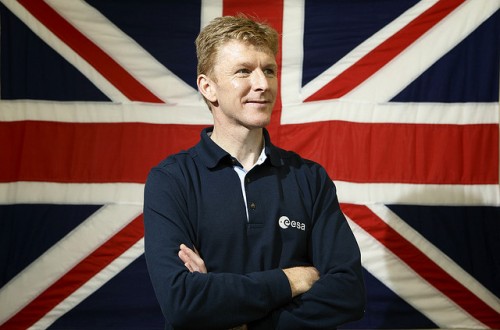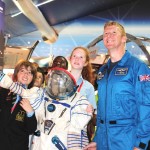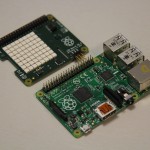Astro Pi: Your Code in Space
Dave: We’re really happy to announce a new project in partnership with British ESA Astronaut Tim Peake, UK Space and the European Space Agency: we’re sending Raspberry Pis to the International Space Station! Read on to find out how to get your code running on them…
Leading UK space organisations have joined forces with British ESA Astronaut Tim Peake and Raspberry Pi to offer students a chance to devise and code their own apps or experiment to run in space. Two Raspberry Pi computers are planned to be flown to the International Space Station (ISS) as part of Tim’s 6 month mission and both will be connected to a new “Astro Pi” board, loaded with a host of sensors and gadgets.
Launched today (10 Dec 2014) at an event held by the UK Space Agency, the Astro Pi competition will be officially opened at the BETT conference (21-24 January) and will be open to all primary and secondary school aged children who are resident in the United Kingdom. The competition will be supported by a comprehensive suite of teaching resources that are being developed by ESERO-UK and Raspberry Pi.
During his mission, Tim Peake plans to deploy the Astro Pi computers in a number of different locations on board the ISS. He will then load up the winning code whilst in orbit, set them running, collect the data generated and then download this to Earth where it will be distributed to the winning teams.
Speaking at the Astro Pi launch event, Dr David Parker, Chief Executive of the UK Space Agency, also revealed that the UK Space Agency has been given a £2 million programme, as part of the Chancellor’s Autumn Statement, to support further outreach activities around Tim’s mission, particularly to help inspire interest in STEM subjects.
Business Secretary Vince Cable said:
So much technology relies on big data but not enough people are being trained in this field. This challenge helps the next generation to have fun whilst learning the skills that industry need.
Creating tomorrow’s engineers is part of our industrial strategy that gives a long term commitment to world-class skills.
Tim Peake added:
I’m really excited about this project, born out of the cooperation among UK industries and institutions. There is huge scope for fun science and useful data gathering using the Astro Pi sensors on board the International Space Station. This competition offers a unique chance for young people to learn core computing skills that will be extremely useful in their future. It’s going to be a lot of fun!

Major Tim Peake – photo provided by UK Space Agency under CC BY-ND
To help students on their way in developing their code, five inspirational themes have been devised to stimulate creativity and scientific thinking. The themes are Spacecraft Sensors, Satellite Imaging, Space Measurements, Data Fusion and Space Radiation.
In the primary school age category, teams will be asked to devise and describe an original idea for an experiment or application which can be conducted on the Astro Pi by Tim during his mission. The two best submissions will get the opportunity to work with the Astro Pi team to interpret their ideas and the team at the Raspberry Pi Foundation will then code them ready for flight on the ISS.
In the secondary school age group, the competition will be run across three age categories, one for each of Key Stages 3, 4 and 5 (in England and Wales, and their equivalent ages in Scotland and Northern Ireland). In the first phase, competitors can submit their ideas for experiments and applications. At least the best 50 submissions in each age category will win a Raspberry Pi computer and an Astro Pi board on which to code their idea. In phase 2, all teams will develop code based on their original concept and two winning teams will be selected in each age category. The winning teams’ code will be readied for flight by the Raspberry Pi Foundation and CGI.
As well as having their code uploaded to the ISS, all winning teams will each receive a class set of Raspberry Pi and Astro Pi boards, meet the Astro Pi team and participate in a winners event during Tim’s flight.
In addition to the main prizes, each of the UKspace companies supporting the project have offered a prize. These prizes will be awarded to the best submission associated with each of the themes, across the age ranges.
ESERO-UK and Raspberry Pi are developing a comprehensive suite of teaching resources to link to the curriculum and assist teachers of STEM subjects in engaging their students in the competition. As well as explaining how to use and write code for the Astro Pi and its sensors, the resources will provide a context for the Astro Pi in the curriculum and link to teaching subjects and areas.
The first two resources of the series are available now in the National STEM Centre eLibrary and the rest will follow.
Launching the Astro Pi computers, and consequently the successful implementation and completion of this competition is subject to nominal progress through the ESA integration programme and operations on-board the ISS.
The organisations involved in the Astro Pi competition include the UK Space Agency, UKspace, Raspberry Pi, ESERO-UK and ESA.
The UKspace team, led by SSTL, include Airbus DS, CGI, the Space KTN, National Nuclear Laboratory and National Physical Laboratory.
Dave: The Astro Pi board will be a Raspberry Pi HAT and will comprise the following:
- Gyroscope, accelerometer and magnetometer sensor
- Temperature sensor
- Barometric pressure sensor
- Humidity sensor
- Real time clock with backup battery
- 8×8 RGB LED display
- Several push buttons
There will also be a camera module attached to the first board and an infra-red camera attached to the second board.
Keep an eye on our blog, the Astro Pi website and @astro_pi on twitter for updates! More information will be made available after the competition launch at BETT in January.
Update: See BBC’s Rory Cellan-Jones interview Tim Peake about the competition: Astronaut Tim Peake invites Raspberry Pi challenge











61 comments
The Raspberry Pi Guy
NOW THIS IS EXCITING! CAPITAL LETTERS ARE REQUIRED!
Space and computers. The two coolest things in one project. Brilliant.
Great work from everyone involved!
The Raspberry Pi Guy
Raspberry Pi Staff Liz Upton
I trust you’ll be entering the competition when it opens in January!
The Raspberry Pi Guy
Just got to come up with an out of this world idea
Ravenous
I’ve often wondered about air circulation in manned vehicles. As there’s no natural convection in zero G, there have always been tales told that forced circulation fans are needed to prevent nasty carbon dioxide pockets building up in corners, especially when crew are sleeping.
Maybe a long term monitor for something like that could be devised. Just a random thought. (if the agencies haven’t researched it already)
desolatemoon
You are quite right, the air inside the ISS is circulated using fans. Without them, the crew would be at risk due to CO2 pockets and all the air cooled equipment would overheat as there is no convection in a weightless environment.
aremvee
Hang on. Doesn’t it say “. . . . will be open to all primary and secondary school aged children who are . . . ” ?
Raspberry Pi Staff Liz Upton
That’s right – The Raspberry Pi Guy is a secondary school student. (Good luck in your mocks, Matt!)
George Dodds (ThePiZone)
Simply brilliant, what a great way to engage kids and encourage them to learn to code!
Martin OHanlon
Love it…
Peter
Awesome! Would be great if this HAT is available outside of the project as well, it’s a pretty cool multi-purpose addon
Ben Nuttall
It will!
Ryan
Do you have any idea when this might be?
Ben Nuttall
Hopefully early in the new year.
Dave Akerman
If you want one flight tested … ;-)
Lonerider
Just had the same idea as Peter. When and how will the Astro Pi HAT be available?
Muc
The hat looks like a great device for many physical computing applications.
Loads of goodies without the hassle of separate components! Nice to be able to focus on just the code :)
Carrie Anne Philbin
Congrats to Dave Honess and Jonathan for all their hard work making this happen. I’m super excited about the competition and all it entails for formal education. Yay Pi in space!
Neil Bizzell
Wow
and great timing too, our Raspberry Pi club have just finished working on the Sonic Pi Space Music. Next terms plan sorted.
A great effort from all involved to get this set up
Ben Coburn
AWSOME! Reminds me of Mir’s packet BBS.
Reads more… Oh now you are just teasing all the older “children” and international readers! >_<
So in the end the code is written by the Raspberry Pi Foundation not the students??? What about time delayed/isolated access to ISS telemetry APIs? Or time delayed internet "cloud" connectivity? What about longer running astronaut support type programs, not just a "play session" with an astronaut?
jdb
The “Big Ideas” from primary school children will be implemented by the Foundation. With secondary/sixth-form students, they themselves will write the code that runs on the Astro-Pis.
One aspect of the Astro-Pi experiment will be operation without any interaction – accumulating a data set from all the onboard sensors with periodic download to Earth. Students can then use this dataset and process or mine it to compare it with data obtained on the ground.
Ravenous
You mentioned international readers – if you’re in the USA then NASA have been doing various outreach schemes with US schools. You could perhaps get involved in one of those.
W. H. Heydt
Two things immediately leap to mind..
First, this might be the one exception to the general statement that a Raspberry Pi does not need a fan (normal convection isn’t going to work in a microgravity environment).
Second, may one presume that the Pis will be left on the ISS at the end of Tim’s tour? After all…why both bringing them back down when there could be follow-on experiments? Plus, one could study how well a Pi continues to work in space with regards to such additional radiation exposure as there is in low Earth orbit.
Nate Olander
Bother it all! I’m in the USA and there are so many AWESOME contests, that I can’t enter. >.<
I love the Raspberry Pi and this is a great idea, can't wait to see how it turns out, but international users need some love too!
Anyways, best of luck to the entrants!
Michael Horne
Pi in Space. Splendid, just splendid. Splendid is a word that isn’t used much nowadays, but it applies here :-)
Congrats on seeing this idea through to fruition :-) Can’t wait to hear all about the ideas that kids come up with.
Brilliant! :-) (And splendid, not forgetting that!)
Raspberry Pi Staff Liz Upton
Not to mention terrific and marvellous! (You might have guessed – we’re VERY excited.) :)
ednl
Pi in the Sky!
Dave Akerman
That idiom was appropriated 18 months ago :-)
dave j
I feel sorry for all those people who’d been trying to get the highest Pi record using weather balloons. :)
P.S. Nice 2001 reference in the Astro Pi logo.
Raspberry Pi Staff Liz Upton
Good spot! (Sam, who is responsible for all the lovely graphical stuff you see on our homepage, in our resources and in the animations, designed that logo. We are very lucky to have him.)
Michael Horne
Ooh! Just spotted it! Wow. Eyes like a cat that man!
dave j
No really. I accidentally clicked on the logo and a much bigger version appeared in my browser.
Ben Nuttall
I wrote the code that’s seen in the background. You can find it on GitHub: https://gist.github.com/bennuttall/e73c5ed731f83f9e3d07
AndrewS
:-D
Mark
Just make a new record of unofficial Highest Pi
Dave Akerman
It was always just a matter of time before someone put one in a decent sized rocket and beat my record!
AndrewS
Who’s going to be first to send a Pi to Mars? ;-)
Connor Dawkins
What model of raspberry pi are they going to be using? Also is there an estimated date for when the astro pi HAT’s will be available for commercial sale?
Ben Nuttall
It’ll be a Model B+.
We hope to make the HATs available early in the new year.
Colin Beagrie
Any word on a commercial release yet?
Raspberry Pi Staff Liz Upton
That’ll be coming in a few months, all being well.
Alf
Would it not be great to get the whole world involved by having a small app on board that would send a greeting from the ISS RPi’s when someone on earth, via their own programming, sent a message. Something similar to a little PING/PONG I have running. eg If a PING is sent to port 39513 at http://www.rpibee.com it should reply PONG.
If anyone tests this please tell me result. The PONG could, of course, be altered to any string required.
AndrewS
Works using the “Raw connection type” in PuTTY :-)
Andy Proctor
There is an amateur radio up in space and you can open it up and talk on it with hand held radio while it is overhead. Maybe if a Pi is pulsing a directed light (radio might interfere with ISS) at the earth, that can be seen (IR or something) and read by any Pi’s on the ground, it would make an interactive project with exciting outcomes maybe? You would have to find out when it’s overhead and capture it making it a worldwide project.
aremvee
if that’s the FUNcube, then a lot of broadcast engineers are already playing with the Pi in space related projects of their own. I came across it some months ago, and while I cant dig up the links right now, follow your nose in any direction at the website and you’ll soon find some.
When the Philae was big news a few weeks ago it struck me that those guys were in a time warp, they were playing, ahem, working with 12+ year old technology in controlling the probe, and they’d be very much aware of it, because they’d be messing around with Pi’s with their children at home.
aremvee
and here’s two to get you started
funcubedongle.com/?p=1647
oz9aec.net/index.php/dvb/490-turn-your-raspberry-pi…
There is a third somewhere , highly interesting, I emailed it to the foundation to follow up for a story around 16 Nov but it would have gotten buried quickly
aremvee
dunno what happened there
Ben Nuttall
<a>tags weren’t closed. I’ve fixed the original comment.The Other Peter Green
“Ground Control to Major Tim…”
buzz
Washington, D.C., 12 December 2014
Dear Pi Developers:
Please do not crash the International Space Station.
Thank you.
Sincerely,
National Aeronautics and Space Administration
Ravenous
10 PRINT “HELLO EARTH”
20 GOTO 10
But seriously, that’s probably why the competition is about ideas only, rather than actual code!
jdb
Do you have any idea how much paperwork it takes to certify that your device will *not* crash the International Space Station?
Pro tip: it’s a lot.
bobek
I’m sure it is. But that is SW part :)
On the other hand how do you tell if the PI will be able to work? I mean the radiation and the heat (lack of heat) during getting there?
I assume that the *within* the ISS the radiation level is OK, but what about outside of it?
Is the PI space-proof? What about the HAT?
I reckon that most of the ICs of the spaceships and stuff are expensive because they had to be space-proof (radiation, low temperature).
PS: Pi in the space. Wow. I mean WOW!!
Ravenous
Radiation isn’t really a problem – apparently the folks up on the ISS use a lot of old laptops and similar devices, which aren’t radiation hardened.
The ISS is in a fairly low orbit so the Van Allen belts protect it a bit.
Chris Evans
Amazing! (In both the original meaning and modern usage of the word)
Dr. Michael Danielides
Hello Space RPi fellows,
I am wondering if the RPi hardware was already tested for space applications at vacuum conditions? Are there any out-gazing or thermal test done?
As I understand so far RPi was only (to-be) taken to ISS under normal pressure condition.
Would RPi hardware be robust enough to operate at space conditions (liquid nitrogen temperature up to higher temperaturs and space weather impacts)?
So basically I am asking similar stuff as bobek did above. Only with the aim for RPi operation outside ISS …
John C
We are only testing Astro Pi to work within the pressurised volume of the ISS. Tests include out gassing, and EMC.
It will also be shock/vibe tested in accordance with the profile of the LV, to check it will still operate when it gets delivered to the ISS.
Astro Pi wont be interfacing with any ISS systems. It will only be taking power.
Like Ravenous said, it’s similar to the virtually COTS laptops already flown, and it’s not flight critical!
Astro Pi will be tweeting pictures as it goes through these certification tests. It will be interesting!
Sundar
This is a brilliant competition and one that BCPD Trust plans to promote and get all our young entrepreneurs involved.
First response from our sports club members was very positive and we plan to get few Raspberry Pi kits to get them taking part.
Winfried Ursin
T.hese people should invite raspberry pi youngsters as well I think. It would be even cheaper than using smartphone technology in space!
http://ieeexplore.ieee.org/xpl/login.jsp?tp=&arnumber=6497349&url=http%3A%2F%2Fieeexplore.ieee.org%2Fxpls%2Fabs_all.jsp%3Farnumber%3D6497349
Good luck to everybody, sadly I am way too old to be accepted for a AstroPin project ;-)
Oliver
Correct me if I’m wrong, but I’ve heard that the pi NoIR camera is only sensitive to near-infrared so doesn’t that mean it wouldn’t do too well at capturing infra-red images of the earth, as suggested on their website? “Infrared can be used to detect heat signatures, e.g. for weather forecasting and plant health.” http://astro-pi.org/satellite-imaging-and-remote-sensing/
David Anderman
We are working on a permanent facility for Raspberry PI and Arduinos at ISS, similar to the Nanoracks facility that currently hosts CubeSATs. The facility would provide a more radiation tolerant environment for microcontrollers, as opposed to the general environment of ISS.
One opportunity is to locate the Rasperry Pi outside of ISS, so that webcams and the like could view the Earth, and transmit the images back to Earth.
Christopher Vahlsing
This is amazing. It wasn’t until I was in my 20s building hardware and learning controller programming in college, and here its a completion for grade and high schoolers!!! Actually, the Astro-HAT is pretty cool on its own without the competition. I would like my own to play with. Will they be available for purchase? Also, will the Astro-HAT be compatible with pi 2? The prefab sensor array looks phenomenal for many applications.